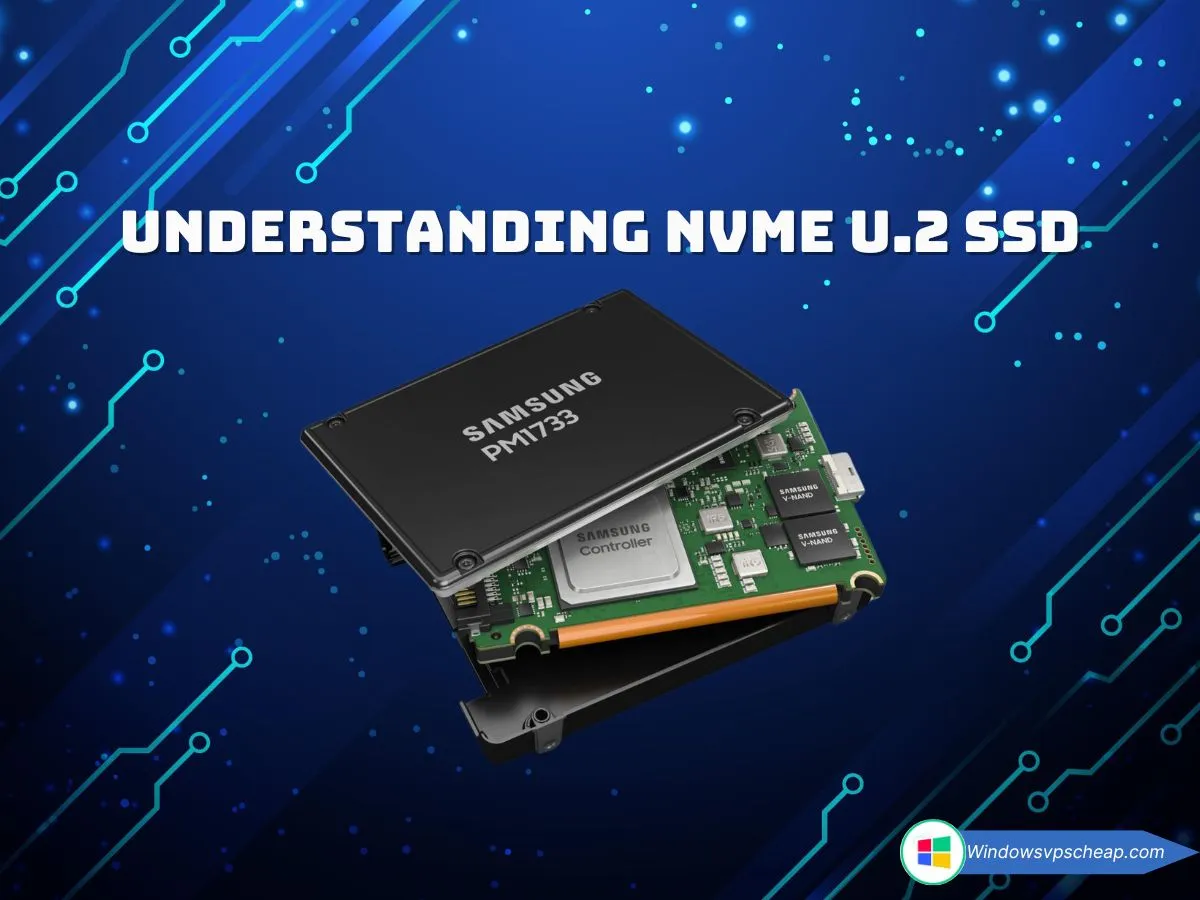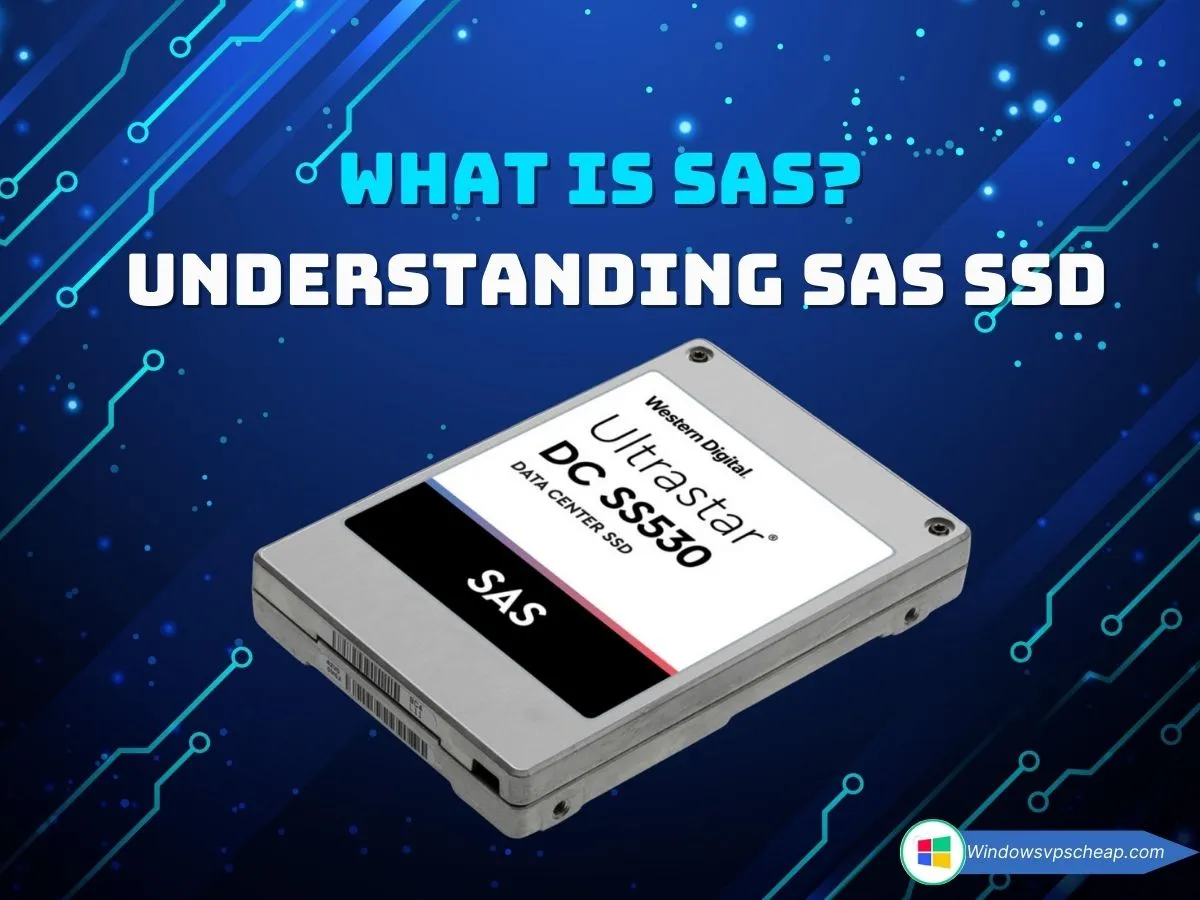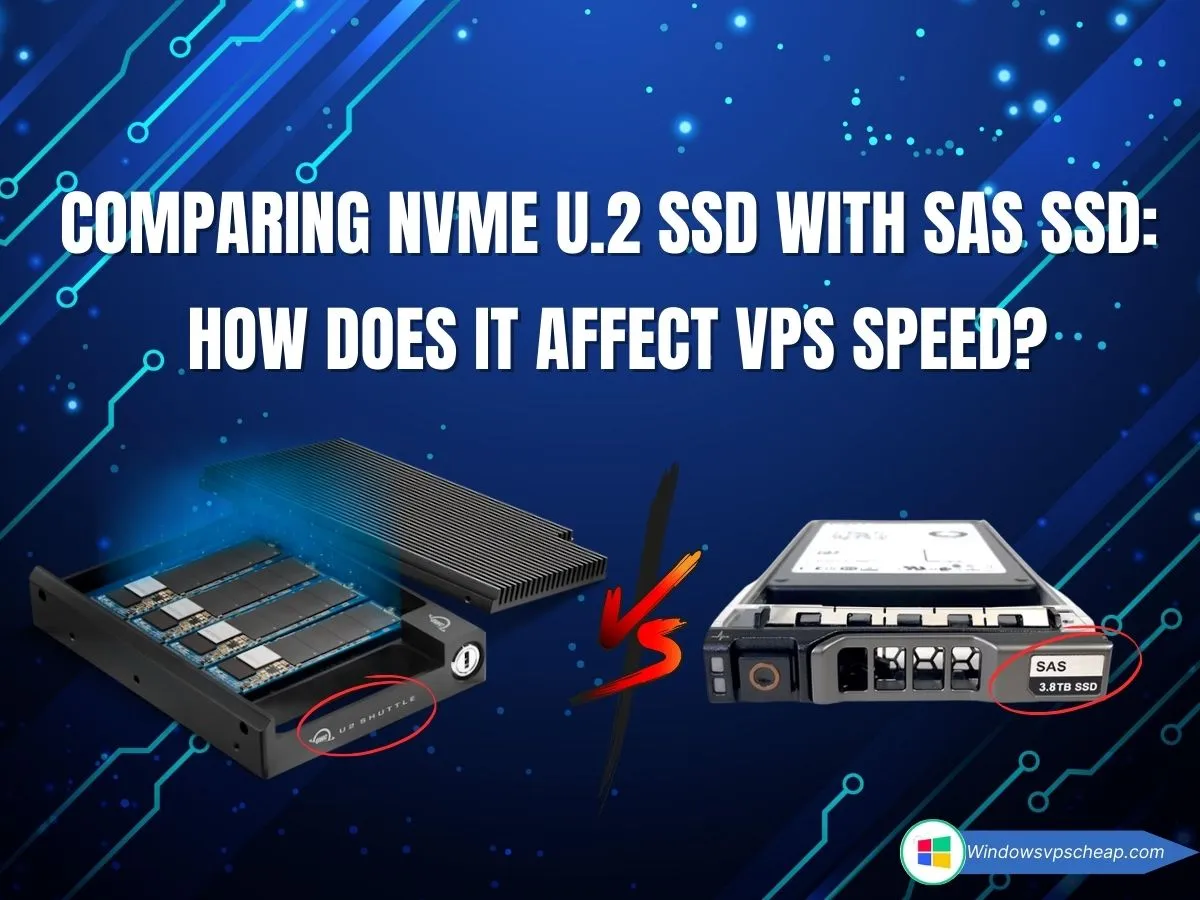In the realm of data storage, SSD (Solid-State Drive) technology has revolutionized how information is accessed and manipulated. The advent of newer, faster storage solutions like NVMe U.2 and SAS SSDs has brought forth dramatic improvements in speed and reliability, crucial factors when considering Virtual Private Server (VPS) performance. Given the critical role of speed in VPS, it is essential to delve deep into how these two types of SSDs NVMe U.2 and SAS compare and ultimately affect VPS speed.
1. Overview of SSD Technologies
SSDs have become the gold standard in storage technology, overshadowing traditional HDDs (Hard Disk Drives). Unlike HDDs, which read and write data using spinning magnetic disks, SSDs store data on flash memory chips, enabling much faster data retrieval speeds. SSD technology has evolved over time, resulting in various interfaces such as SATA, SAS, and NVMe, each offering different levels of performance.
2. Importance of Speed in VPS Performance
VPS performance hinges on several factors, but speed is undeniably one of the most critical. Faster storage solutions can lead to quicker data access and reduced latency, which translates into faster website loading times, better user experience, and improved overall system performance. Speed is especially vital for applications requiring extensive data processing, such as databases, high-traffic websites, and complex computing tasks.
3. Understanding NVMe U.2 SSDs
What is NVMe?
NVMe (Non-Volatile Memory Express) is a communication interface and driver designed to fully utilize the potential of high-speed PCIe SSDs. Unlike older interfaces like SATA and SAS, NVMe capitalizes on the PCIe bus’s low latency and high-speed data transfer capabilities. By connecting directly to the CPU via PCIe lanes, NVMe eliminates bottlenecks associated with older storage technologies, thus offering superior speed and efficiency.
Advantages of NVMe U.2 SSDs
NVMe U.2 SSDs present several significant advantages that make them a compelling choice for high-performance storage needs:
- Blazing Fast Speed: NVMe U.2 SSDs can achieve phenomenal read/write speeds, often exceeding 3500 MB/s, far surpassing the limits of older interfaces.
- High IOPS: The high Input/Output Operations Per Second (IOPS) achieved by NVMe drives ensures rapid and consistent data access, crucial for demanding applications such as databases.
- Low Latency: NVMe’s architecture is designed to minimize latency, providing much quicker response times compared to SAS and SATA.
- Scalability: NVMe can leverage up to 16 PCIe lanes, support multiple command queues, and handle thousands of entries per queue, leading to excellent scalability for future performance improvements.

Speed and Performance Metrics
The performance of NVMe U.2 SSDs is measured through various metrics:
- Sequential Read/Write Speed: This can reach up to 3500 MB/s for reading and 3000 MB/s for writing.
- Random Read/Write IOPS: Typically ranges from 500,000 to 700,000 IOPS.
- Latency: NVMe drives have extremely low latency, usually in the microsecond range, compared to the millisecond ranges of older technologies.
These metrics underline why NVMe U.2 SSDs are often preferred for tasks requiring rapid and reliable data manipulation.
4. Understanding SAS SSDs
What is SAS?
SAS (Serial Attached SCSI) is another mature storage interface known for its reliability and performance. Initially created for HDDs before being adapted for SSDs, SAS uses the SCSI (Small Computer System Interface) protocol to facilitate data transfer. The robust features of SAS include support for dual-port functionality, high redundancy, and error correction, making it a staple in enterprise environments.
Advantages of SAS SSDs
Despite not achieving the same speeds as NVMe, SAS SSDs offer several benefits:
- Reliability and Durability: SAS SSDs are engineered to handle continual read/write operations, making them highly dependable for enterprise usage.
- Dual-Port Functionality: This feature ensures continuous data availability even if one port fails, thus enhancing data integrity and uptime.
- Extensive Compatibility: SAS SSDs are compatible with a vast array of existing systems and infrastructures, facilitating seamless upgrades and integrations.
- Advanced Error Correction: Robust error correction mechanisms improve data integrity, essential for mission-critical environments.

Speed and Performance Metrics
While not as fast as NVMe U.2, SAS SSDs still offer commendable performance:
- Sequential Read/Write Speed: Typically ranges between 1000 MB/s to 1200 MB/s.
- Random Read/Write IOPS: Generally around 200,000 to 400,000, depending on the drive specifications.
- Latency: Higher than NVMe SSDs, but still significantly lower compared to traditional HDDs, usually measured in milliseconds.
These metrics illustrate that while SAS SSDs may lag behind NVMe U.2 in raw speed, they are tailored for reliability and long-term dependability.
5. Compare in detail SSD NVMe U.2 and SSD SAS.
Interface Differences: NVMe vs SAS
The primary difference between NVMe and SAS SSDs lies in their interfaces.
- NVMe: Utilizes PCIe (Peripheral Component Interconnect Express), offering multiple lanes (up to 16) for data transfer directly to the CPU, resulting in much lower latency and higher throughput.
- SAS: Uses the SCSI interface connected via a SAS controller, designed originally for HDDs but later adapted for SSDs. While reliable, it does not match the direct communication efficiency of NVMe.
Speed Comparison: NVMe U.2 vs SAS
| Feature | NVMe U.2 SSD | SAS SSD |
|---|---|---|
| Max Read Speed | Up to 3500 MB/s | Up to 1200 MB/s |
| Max Write Speed | Up to 3000 MB/s | Up to 1000 MB/s |
| Random Read IOPS | 500,000 – 700,000 | 200,000 – 400,000 |
| Random Write IOPS | 400,000 – 600,000 | 150,000 – 350,000 |
As observed, NVMe U.2 SSDs outperform SAS SSDs by a significant margin in both sequential and random read/write operations.
Latency Differences Between NVMe and SAS
Latency is another critical factor distinguishing NVMe and SAS SSDs:
- NVMe: Due to its direct connection to the CPU via PCIe, NVMe SSDs typically have much lower latency, often measured in microseconds.
- SAS: While offering better latency than traditional HDDs, SAS SSDs still measure latency in milliseconds, making them slower in terms of data access times compared to NVMe drives.
Data Transfer Rates: Real-World Benchmarks
Real-world benchmarks reinforce the theoretical differences between NVMe U.2 and SAS SSDs. An independent study by Tom’s Hardware revealed that NVMe drives achieved speeds upwards of 3000 MB/s in sequential reads and writes in various test scenarios, while high-performing SAS SSDs maxed out at around 1200 MB/s.
Cost Considerations
Price Comparison: NVMe U.2 vs SAS SSD
| Specification | NVMe U.2 SSD | SAS SSD |
|---|---|---|
| Price per GB | $0.20 – $0.50 | $0.10 – $0.30 |
| Overall Cost for 1TB | $200 – $500 | $100 – $300 |
| Additional Costs (Infrastructure) | Higher (due to PCIe) | Lower (standard SAS setup) |
While the upfront cost for NVMe U.2 SSDs is often higher, the significant performance gains justify the investment, particularly for applications where speed is paramount.
Cost-Effectiveness for VPS
The cost-effectiveness of each solution depends on the specific needs of the VPS deployment:
- NVMe U.2 SSDs: Best for high-performance, data-intensive applications where speed justifies the higher initial investment.
- SAS SSDs: Ideal for environments where reliability, durability, and cost-efficiency are the primary considerations.
Reliability and Durability
Endurance Ratings: NVMe vs SAS
| Attribute | NVMe U.2 SSD | SAS SSD |
|---|---|---|
| Typical Endurance (TBW – Terabytes Written) | 500 – 1000 TB | 300 – 600 TB |
| Lifespan | Up to 10 Years | 5 – 7 Years |
Both NVMe and SAS SSDs offer impressive endurance, though NVMe drives tend to have a slight edge in terms of overall lifespan.
Data Integrity and Error Correction Mechanisms
NVMe U.2 and SAS SSDs ensure data integrity through advanced error correction mechanisms:
- NVMe: Employs techniques like end-to-end data protection, providing comprehensive data integrity checks.
- SAS: Utilizes robust error correction through SCSI protocols, ensuring data reliability even in failure scenarios.
Scalability and Compatibility
Expansion Capabilities of NVMe U.2 SSDs
NVMe U.2 SSDs are highly scalable, capable of leveraging multiple PCIe lanes for data throughput. Their architecture supports large-scale deployments, making them well-suited for expanding data environments.
Compatibility of SAS SSDs with Existing Systems
One of SAS SSDs’ strengths is their broad compatibility with existing systems. They integrate seamlessly into infrastructures already utilizing the SCSI protocol, allowing for easier upgrades without necessitating a complete overhaul of existing environments.
6. Impact on Virtual Private Server (VPS) Speed
How Storage Performance Affects VPS Performance
The storage performance is a key determinant of VPS speed and effectiveness. Enhanced storage solutions translate into faster data access, reduced latency, and seamless performance under heavy workloads. For instance, server response times, boot times, and overall user experiences significantly improve with faster SSDs.
Use Cases for NVMe U.2 SSD in VPS
NVMe U.2 SSDs are ideal for:
- High-Traffic Websites: Websites experiencing heavy traffic benefit from faster data retrieval and improved loading times.
- Database Management: Applications requiring rapid, consistent access to large data sets see noteworthy improvements in performance.
- Media Intensive Applications: Video editing, game hosting services, and other media-rich applications experience smoother operation and reduced latency.
Use Cases for SAS SSD in VPS
SAS SSDs are well-suited for:
- Enterprise Environments: Applications where reliability and durability outweigh the need for the highest possible speed.
- Data Warehousing: Systems that emphasize redundancy and error correction over blazing-fast performance.
- Cost-Conscious Setups: Environments where budget constraints limit the feasibility of NVMe solutions while still requiring dependable SSD performance.
7. Choosing the Right SSD for VPS
NVMe U.2 SSD: Advantages and Disadvantages
Advantages:
- Superior speed and performance
- Excellent scalability
- Low latency
Disadvantages:
- Higher cost
- Requires specific infrastructure
SAS SSD: Advantages and Disadvantages
Advantages:
- High reliability and durability
- Cost-effective
- Broad compatibility
Disadvantages:
- Lower speed compared to NVMe
- Higher latency
Factors to Consider When Choosing SSD
When selecting an SSD for VPS, considerations should include:
- Performance Needs: High-speed and low-latency requirements.
- Budget Constraints: Initial costs and long-term ROI.
- Reliability: Necessary for mission-critical applications.
- Scalability: Future expansion and performance scaling requirements.
- Compatibility: Ease of integration with existing systems.
8. Future Trends
Emerging Technologies in SSDs
As SSD technology evolves, emerging trends include:
- QLC (Quad-Level Cell): Increasing storage capacities.
- 3D NAND: Improving density and endurance.
- Optane Memory: Bridging the gap between storage and RAM for near-instantaneous data access.
Predictions for NVMe and SAS SSDs in VPS Solutions
Future trends indicate that NVMe SSDs will dominate the high-performance segment of the VPS market, driven by continuous advancements in their technology. As NVMe becomes more affordable, its adoption will likely increase, gradually replacing SAS SSDs, which will retain their niche in applications that prioritize robustness and compatibility over peak performance.
9. Conclusion
Summary of Key Differences
The critical differences between NVMe U.2 and SAS SSDs lie in their performance metrics, cost, and suitability for different applications. NVMe U.2 SSDs offer unmatched speed and low latency, making them ideal for performance-centric environments, while SAS SSDs provide reliable and cost-effective solutions for enterprise requirements.
Recommendations for VPS Deployment
For VPS deployments prioritizing speed and user experience across high-traffic, data-intensive applications, NVMe U.2 SSDs are the clear choice. Conversely, for environments needing reliability, broad compatibility, and cost-efficiency, SAS SSDs remain a viable option. Ultimately, the selection should align with specific VPS needs, balancing performance, cost, reliability, and scalability considerations.
By comprehensively understanding the distinctions and applications of NVMe U.2 and SAS SSDs, stakeholders can make informed decisions, optimizing VPS deployments to meet current and future demands.
>>> You may be interested in: SSD Consumer VS SSD Enterprise – How to choose SSD hard drive for server
For more insights into the latest technology trends and hardware reviews, stay tuned to our blog. If you have any questions or need personalized advice, feel free to reach out to our support team.
CATEGORY:Knowledge

